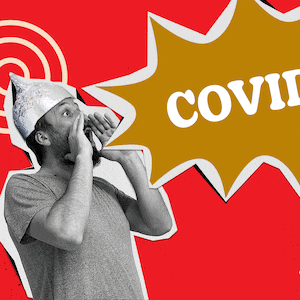We’re starting to get a handle on how monkeypox is spreading in this latest outbreak of the deadly disease.
The pox spreads through close physical contact. Especially during sex.
Believe it or not, that’s actually a relief. Because one possible alternative—the pox spreading through the air—is much, much more dangerous.
The World Health Organization recently confirmed the transmission methods driving the three-week-old outbreak in Europe, Australia, and the United States. “Based on currently available information, cases have mainly but not exclusively been identified amongst men who have sex with men seeking care in primary care and sexual health clinics,” the WHO stated last week.
That doesn’t mean monkeypox—a pathogen that is endemic in rodent and monkey populations in West and Central Africa and causes flu-like symptoms and a rash in people (and can be fatal in up to 10 percent of cases, depending on the precise strain)—is a sexually transmitted disease.
In fact, experts are clear that it’s not. Instead, it’s an opportunistic disease that prefers to jump from an infected person to an uninfected one via tiny cuts in the skin or the mucus membranes of the nose, mouth, and anus. “Any close contact will allow for spread,” Blossom Damania, a virologist at the University of North Carolina at Chapel Hill, told The Daily Beast.
So it should come as no surprise, then, that men having sex with other men is a significant factor in the pox’s spread. David Heymann, who formerly headed the WHO’s emergencies department, told The Associated Press that men attending raves in Spain and Belgium—and getting frisky with each other—“amplified” the outbreak.
“What’s happened is, it’s gotten into a population which is amplifying transmission because of behavior,” Heymann told The Daily Beast.
Mateo Prochazka, an infectious disease epidemiologist at the U.K. Health and Security Agency, said he was worried that these discoveries would be misconstrued in a way that could be used to attack the gay community, of which he is a member.
“It does not mean that gay or bisexual men are doing anything inherently wrong, or that the virus has changed or that it’s sexually transmitted, it just means that this behaviour facilitates transmission in these networks,” he told PinkNews. “We wanted to make sure people understand that transmission is not exclusive to gay and bisexual men, it just happens that it has entered this network.”
There was widespread concern, early in the outbreak, that this strain of the pox might spread the way COVID spreads—in the air when we breathe, cough, speak, laugh.
So, the sexual aspect of the viral transmission is actually a cause for relief among epidemiologists as the number of confirmed cases—around 100 in a dozen countries outside of Africa, as of Monday—slowly climbs. (No deaths have been reported.)
“We still don’t fully understand the extent of the outbreaks or the modes of transmission,” Lawrence Gostin, a Georgetown University global health expert, told The Daily Beast last week.
COVID of course likes to travel in the very fine “aerosol” mist that everyone exhales every few seconds. Those aerosols can travel across rooms and linger in the air for minutes at a time. That’s part of what makes COVID so contagious.
Experts suspected that monkeypox tends to favor larger droplets that don’t travel as far or linger as long. “Monkeypox is not airborne, but transmits via droplets after prolonged contact,” the European Center for Disease Prevention and Control—Europe’s version of the U.S. Centers for Disease Control and Prevention—told The Daily Beast in a statement. In other words, it seemed unlikely the pox would spread like COVID and potentially trigger its own pandemic.
But viruses are unpredictable. The idea that the pox might have mutated in order to ride on aerosols kept a lot of epidemiologists awake at night earlier this month even though this is a DNA virus so cannot mutate as readily as an RNA virus like COVID. The world is barely managing to handle one pandemic. The last thing we need is a second global disease on top of the first.
We can relax… somewhat. Inasmuch as the pox is mostly spreading through very close contact—kissing, fondling, sex—it’s fairly straightforward to keep from passing it along. “This disease can be contained by behavior-change,” Heymann said.
It starts with education. Know what the pox looks like—hard, circular blisters—and don’t touch anyone showing signs of infection. But there’s no need for paranoia. You’re probably not going to catch the pox by simply sharing air with an infected person.
And even if you do catch it, you’ve got options for swift treatment. Monkeypox is related to smallpox and the same vaccines work against both. The CDC alone stockpiles more than 100 million doses of the pox vaccines.
Not only can the latest and best pox vaccine, Jynneos, prevent infection—it also works as a therapy after infection, Heymann pointed out. “It changes the virus.” The catch is, you have to take a dose within a few days of getting sick.
Between contact-tracing, vaccines, and therapies, we’ve got the tools to contain monkeypox and prevent most of the possible deaths from the virus. And now that we’re zeroing in on the major transmission pathways, we can begin to rule out the likelihood of a pox pandemic. “I expect it to be contained in high-income countries,” Gostin said.
To stand a good chance of spreading the pox, you’ve got to get up close and real personal with someone else. That doesn’t lend itself to out-of-control spread.








